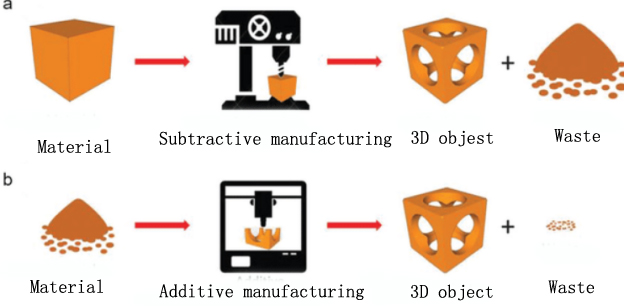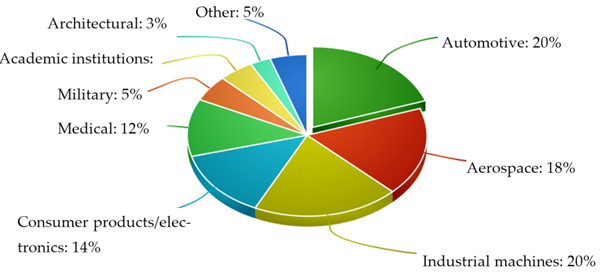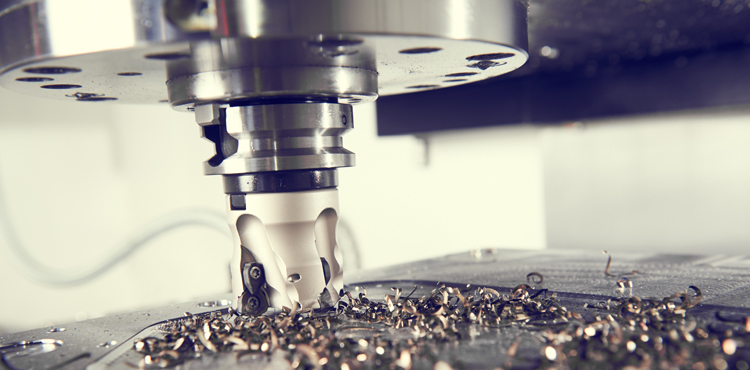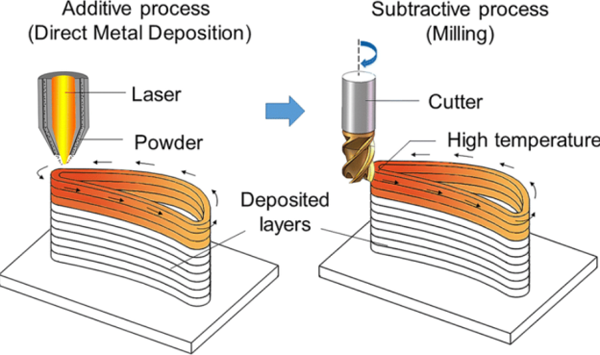Welcome to the Essential Guide on Additive vs Subtractive Manufacturing. In this blog, keen minds explore two powerful ways to make stuff. Knowledge gets a spotlight, showing how each process turns materials into awesome things. Industries like cars, planes, and hospitals use these methods.
This guide clears the fog, helping to pick the best way. Expert insights light the path through materials, tools, and tips. So, let's dive into this sea of wisdom.

Additive manufacturing begins with a digital design. Computer software slices this model into thin layers. Then, machines create parts by adding material, layer by layer. Additive manufacturing makes complex designs possible.
Polylactic Acid (PLA): Biodegradable, PLA finds wide use in packaging, disposable cutlery, and medical implants.
Acrylonitrile Butadiene Styrene (ABS): ABS is robust and heat-resistant. Ideal for products requiring durability and strength.
Polyethylene terephthalate glycol (PETG): With excellent durability, PETG becomes choice material for mechanical parts.
Nylon: Known for flexibility and strength, nylon is popular in fashion and automotive industries. Additionally, nylon is often processed in a VMC machine to create precision components.
Thermoplastic Elastomers (TPE): TPE can stretch and return to original shape. Use extends to automotive, medical, and consumer goods.
Polypropylene (PP): Lightweight yet sturdy, PP is essential in packaging, automotive, and textile industries.
Polycarbonate (PC): PC is known for high impact resistance and transparency. Used in eyewear, automotive parts, and protective gear.
High Impact Polystyrene (HIPS): With high dimensional stability, HIPS finds its place in toys and product casings.
Wood: In additive manufacturing, wood is processed into filament form. Applications include decoration and modeling.
Metal: Metals like titanium and stainless steel are used in aerospace and medical fields.
Ceramic: Ceramics, with their heat resistance, are important in industries like electronics and medical.
Resin: Durable and detailed, resin is valuable in jewelry and dental sectors.
Aerospace: Building intricate, lightweight components is key. Additive manufacturing provides the solution.
Automotive: Rapid prototyping and customizable parts are achievable with additive manufacturing.
Medical: From surgical tools to prosthetics, additive manufacturing revolutionizes healthcare.
Dental: Additive manufacturing enables precise dental implants and orthodontic devices.
Jewelry: Complex designs with high precision become possible with additive manufacturing.
Footwear: Customized soles and patterns? Additive manufacturing makes it happen.
Education: Additive manufacturing offers hands-on learning opportunities, sparking creativity.
Research: Experimenting with new materials and designs, additive manufacturing paves the way.
Construction: Creating architectural models or even actual building elements, additive manufacturing leads the way.

Subtractive manufacturing begins with a solid block. Imagine a block of cheese. Next, machines shave off pieces. Now, envision the block shaped like a race car. Imagine, 3D computer models guide the machines. In fact, computer numerical control, or CNC, commands the tools.
Mainly, drills and cutters shape the block. Plus, waste gets removed. So, subtractive wins in precision. Sadly, 30% of the material might be waste. Overall, subtractive shapes parts from solids.

Aluminum: Airplanes love aluminum. Why? It’s light and strong. Plus, it fights rust. Machine tools shape it easily.
Brass: Musicians value brass. Trumpets sing because of brass. Machines form it into tubes and bells.
Bronze: Artists crave bronze. It transforms into statues. Bronze statues stand tall for centuries.
Copper: Wires need copper. Copper helps electricity flow. Radiators and pipes love copper too. When making intricate components, a precision mold is often used to shape copper efficiently.
Steel: Buildings trust steel. Steel makes beams. Beams hold up tall buildings.
Stainless Steel: Kitchens adore stainless steel. Pots and pans use it. It does not rust or stain.
Titanium: Spaceships count on titanium. High strength, low weight. Great for flying into space.
Wood: People build with wood. Houses, tables, chairs. Tools cut wood into shapes.
Acrylic: Signs use acrylic. Bright, clear, and durable. Perfect for outdoor signs.
Polycarbonate: Safety goggles embrace polycarbonate. Tough, clear, and safe. Protects eyes from harm.
HDPE: Milk jugs are HDPE. HDPE stands for High-Density Polyethylene. It keeps milk fresh.
ABS: LEGO blocks use ABS. ABS means Acrylonitrile Butadiene Styrene. It’s tough and builds fun toys.
PTFE: Non-stick pans trust PTFE. PTFE is Teflon. Food slides off with ease.
Automotive: Cars need parts. Subtractive manufacturing makes engines, gears. Precise parts for smooth rides.
Aerospace: Planes and rockets soar. Titanium and aluminum get shaped. Light, strong parts fly high.
Marine: Boats navigate oceans. Engines, propellers come from subtractive.
Medical: Health is priceless. Implants, surgical tools matter. Precision saves lives, subtractive helps.
Construction: Buildings rise up. Steel, wood, essential. Subtractive shapes a city’s heart.
Energy: Power keeps lights on. Turbines, generators core parts. Subtractive powers them to life.
Electronics: Phones, computers need chips. Subtractive crafts tiny parts. Connects the world with technology.
Furniture: Homes need comfort. Chairs, tables to gather. Wood, metals bring families together.

Material Use: In subtractive manufacturing, solid blocks of material get cut down. The result - parts of precise shapes. Additive manufacturing, on the contrary, builds pieces from the ground up. Layer by layer, the material is added to form the final product.
Energy Efficiency: Subtractive methods consume considerable energy, specifically in machine setup and tooling processes. Additive manufacturing stands out for lower energy use during fabrication, offering a more sustainable choice.
Labor Costs: Skilled labor is a necessity for subtractive manufacturing. Training and operating costs, thus, soar. Additive methods, though, require less manual intervention. Consequently, labor expenses decline.
Waste Generation: Chips, cuttings, and other material scraps abound in subtractive manufacturing. The additive approach, however, employs just the material needed. Waste is minimized.
Production Time: For complex geometries, additive manufacturing outpaces its subtractive counterpart. Subtractive processes may take longer due to extensive tooling and setup periods.
Flexibility: Owing to its layer-by-layer construction, additive manufacturing embraces complex designs. Subtractive techniques might struggle with intricate structures due to tooling limitations. A CNC vertical machining center helps in enhancing flexibility and reducing production time in subtractive manufacturing.
Tooling Requirements: Tooling for subtractive processes can be costly and time-consuming. Additive manufacturing requires no specific tooling, reducing associated costs and time.
Surface Finish: Subtractive manufacturing can achieve superior surface finishes. Additive manufacturing, though, may need post-processing to improve surface quality.
Part Strength: Subtractive manufacturing often results in stronger parts due to less internal stress. Additive processes may yield parts with internal stress, affecting strength.
Design Complexity: Complex designs are easy for additive manufacturing. Subtractive methods, however, may limit design complexity due to tooling restrictions.
Volume Production: Subtractive manufacturing reigns supreme for high volume production. Additive techniques usually shine in lower volume runs.
Prototyping: Speed and flexibility make additive manufacturing an excellent choice for prototyping. Subtractive methods might not be as efficient or cost-effective for prototype creation.
Prototyping:
Quick turnarounds and easy design alterations make additive manufacturing ideal for prototypes. High levels of detail and accuracy can be achieved with fewer resources.
Complex Geometries:
Additive manufacturing has the edge when dealing with intricate designs. Building structures layer by layer allows for complexity unachievable by subtractive methods.
Customization:
Additive manufacturing thrives in producing custom parts. Personalized designs are easily accommodated without additional tooling or setup costs.
Small Batch Production:
Additive techniques are cost-effective for small batch production. No extra tooling cuts down setup times and overall costs.
Lightweight Parts:
By allowing hollow structures and lattice designs, additive manufacturing creates lighter, yet strong parts. Traditional subtractive methods may struggle with such designs.
Multi-Material Parts:
Manufacturing with multiple materials is a forte of additive methods. Subtractive techniques often restrict the use of various materials in one piece.
Low Waste Production:
Additive manufacturing uses only necessary material, reducing waste. In contrast, subtractive methods produce more scrap material.
Hollow Structures:
Additive manufacturing effortlessly creates hollow structures. Subtractive methods might face difficulties, leading to higher costs and longer production times.
Tooling Production:
Additive techniques can swiftly produce tooling and fixtures, enhancing productivity. Subtractive methods might take longer and prove more expensive.
Reduced Assembly:
Additive manufacturing can create complex assemblies as a single part, reducing assembly needs. Subtractive methods often necessitate separate parts for assembly, raising production time and cost.
In subtractive manufacturing, massive numbers like 10,000 pieces can be made swiftly. Great for big orders.
Machines carve out shapes to be super exact. For jet engines, where millimeters matter, this is top-notch.
Making solid car parts? Subtractive manufacturing forms robust, durable pieces that don't break easily.
Aluminium, titanium, and plastics - all fair game. Pick from a big list for various needs.
No bumps or rough spots. Products look and feel silky smooth, pleasing to touch.
Subtractive manufacturing excels in big items. Think boat hulls and airplane wings.
Circles, squares, and triangles. For simple shapes, subtractive manufacturing is a sure winner.
Basic products don’t cost much. Your wallet stays happy when making simple designs.
Finding subtractive manufacturing services is easy. Options abound for your projects.
Many years of trust. Industry experts nod in approval at subtractive manufacturing’s track record.
Additive manufacturing speeds like lightning. In hours, your design springs to life.
Subtractive manufacturing consumes more energy. Meanwhile, 3D printers sip little power.
Say no to trash. Additive manufacturing uses nearly 98% of materials, leaving almost no waste.
Subtractive scores in precision. Additive follows closely, crafting finely detailed products. The use of an engraving and milling machine can further enhance the precision of subtractive manufacturing.
Need more products? Additive manufacturing can scale up easily without hiccups.
Dream big. Additive manufacturing brings even the wildest designs to reality.
Reliable as a well-tuned clock. Additive manufacturing yields uniform products every time.
Both types boast low error rates. Precision tools keep mistakes down to a minimum.
Additive manufacturing starts faster. No need to wait for tooling and molds.
Additive makes complex designs faster. For simpler products, subtractive takes the crown.
Strength: Subtractive manufacturing often yields stronger parts due to material continuity. Meanwhile, additive manufacturing builds layer-by-layer, sometimes affecting bond strength.
Durability: Subtractive methods can handle more wear, especially in heavy-duty scenarios. Additive parts offer durability in design-sensitive applications.
Surface Finish: Subtractive offers smoother surfaces. Additive parts may need post-processing for similar finishes.
Material Properties: Additive methods accept a broader range of materials, including ceramics and metals. Subtractive methods primarily work with metals.
Part Consistency: Subtractive manufacturing offers consistent parts, thanks to computer-controlled precision. Additive faces challenges with layer inconsistency.
Dimensional Accuracy: Subtractive methods excel in dimensional accuracy. Additive methods can match up, but may require fine-tuning.
Repeatability: Both methods offer good repeatability. However, subtractive can be quicker for larger batches.
Process Control: Subtractive gives more control over the process. Additive manufacturing provides control over internal structures.
Material Flexibility: Additive manufacturing shines here, working with a variety of materials. Subtractive is somewhat limited.
Design Freedom: Additive manufacturing enables complex geometries and internal structures. Subtractive is limited to accessible surfaces.

Cleaning Procedures: Subtractive machines require regular chip removal. Additive printers need periodic removal of unused material.
Scheduled Maintenance: Both types require regular checks. Additive printers may need more frequent nozzle cleaning.
Calibration: Calibration is crucial for both. Additive manufacturing machines need regular bed leveling.
Part Replacement: Wear parts for subtractive machines include drill bits. Additive printers often need nozzle replacements.
Wear and Tear: Subtractive machines may show wear due to constant material removal. Additive printers wear mainly at the nozzle.
Tool Lifespan: Tools in subtractive machines usually have longer lifespans. Nozzles in additive machines may wear faster.
Inspection Schedules: Regular inspection is necessary for both, considering safety and accuracy.
Operational Checks: Both types require daily operational checks to ensure smooth running.
Lubrication: Subtractive machines need more frequent lubrication. Additive printers require less.
Safety Precautions: Subtractive methods involve more safety risks due to chips and dust. Additive machines pose fewer safety hazards.
Geometric Complexity: In additive manufacturing, complex designs prove no hurdle. Subtractive techniques, on the other hand, struggle with intricate geometries.
Material Selection: Additive processes support diverse materials. Subtractive methods offer fewer choices.
Tolerances: Tight tolerances are achievable in subtractive processes. Additive techniques might lack precision.
Surface Finish: Subtractive techniques provide excellent finishes. Additive methods may require post-process finishing.
Part Size: Subtractive manufacturing handles large parts better. Additive techniques excel with small, complex parts.
Production Volume: For high-volume production, subtractive methods stand out. Additive techniques suit low-volume, customized parts.
Post-Processing: Subtractive processes demand less post-processing. Additive methods require finishing steps.
Assemblies: Additive manufacturing allows for consolidated assemblies. Subtractive processes might necessitate separate assembly stages.
Cost Factors: Subtractive methods have predictable costs. Additive techniques may incur extra costs for material, labor, or equipment.
Production Speed: Subtractive manufacturing offers fast production for simple designs. Additive techniques provide swift turnaround for complex parts.
Design Flexibility: Hybrid manufacturing harnesses the power of both techniques, yielding high design flexibility.
Multi-Material Possibilities: Hybrids use multiple materials in one part, expanding creative possibilities.
Waste Reduction: Combining processes can optimize material use, reducing waste significantly.
Precision Enhancement: Hybrid techniques refine precision, capitalizing on the strengths of both methods.
Speed Optimization: Hybrid manufacturing optimizes speed, utilizing each process where most efficient.
Cost Savings: The hybrid approach can lead to cost savings by reducing material waste and shortening production time.
Quality Improvement: By capitalizing on the strengths of both methods, hybrid manufacturing can enhance overall quality.
Strength and Durability: Hybrid processes yield products with higher strength and durability, due to optimal material usage.
Product Lifespan: Products manufactured through hybrid processes tend to have longer lifespans, thanks to improved strength and quality.
Innovation Potential: With expanded design and material possibilities, hybrid manufacturing holds vast potential for innovation.
Marvel at the world of Additive vs Subtractive Manufacturing unraveled in this guide. The reader peered into how raw materials transform into final products. Key industries harness these techniques to craft aircraft, cars, medical tools, and more. Therefore, knowing which suits a project best is paramount.
So, wield this knowledge like a pro. Take the next step by visiting CNCYANGSEN to empower future creations.